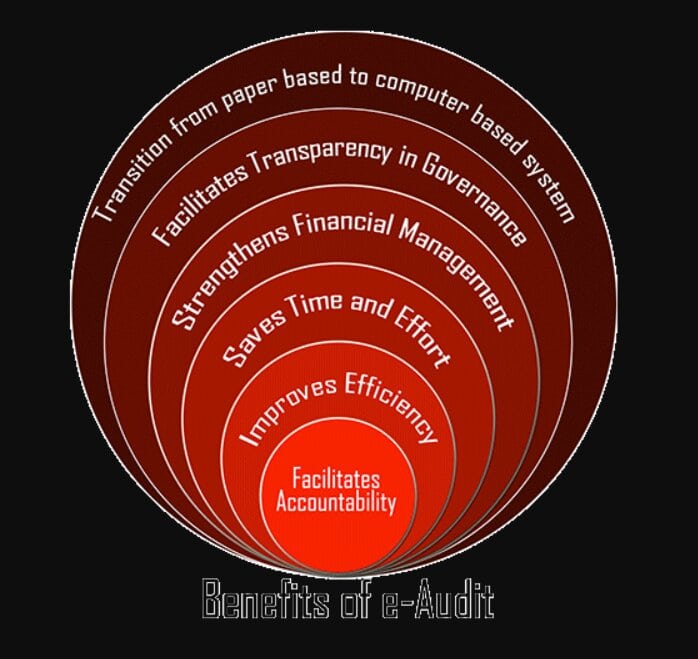Governance
AuditOnline Application for Local Bodies
- 25 Jul 2020
- 7 min read
Why in News
The Ministry of Panchayati Raj has decided to conduct an online audit of accounts of about 50,000 Gram Panchayats (GPs) through its application AuditOnline during the current financial year (2020-21).
- This will be the first such exercise.
Key Points
- Online Audit of Accounts: 50,000 GPs’ books of accounts for 2019-20 will be audited with a focus on how they used Finance Commission (FC) grants.
- 50,000 is equivalent to the 20% of the estimated 2.5 lakh GPs across the country.
- In the next financial year (2021-22), the exercise will be scaled up to cover all the GPs.
- The 15th FC recommended an allocation of Rs. 60,750 crore for rural local bodies during 2020-21, almost the same as last year under the 14th FC.
- AuditOnline:
- It is an application developed as a part of Panchayat Enterprise Suite (PES) under e-panchayat Mission Mode Project (MMP) initiated by the Ministry of Panchayati Raj (MoPR).
- It facilitates the financial audit of accounts at all the three levels of Panchayats viz District, Block and Village Panchayats, Urban Local Bodies (ULB) and Line department by Auditors.
- It not only facilitates the online and offline audit of accounts but also serves the purpose of maintaining the past audit records of the auditee with associated list of the auditors and audit team involved in the audit.
- Also the information remains available in public domain and for usage by other PES applications.
- Benefits of Online Audit:

- Online audit with the option of physical verification assumes greater relevance given the pandemic and the lockdown.
- As some works (done under other schemes) are geo-tagged, auditors can do a sample check by visiting the site.
- Further, it ensures accountability in the utilisation of funds at the ground level.
- In the offline system, timely availability of records is a major issue. However, in the online system, the auditors will be able to see online all documents related to work approval and payments. They can even ask for additional documents such as photographs as a proof of work done.
- Moreover, an online audit can be monitored at all levels: district-state-centre.
- Online audit with the option of physical verification assumes greater relevance given the pandemic and the lockdown.
- Challenge:
- More than 15% of Panchayats in several states have not completed their books of accounts for the year 2019-20.
- Completing and closing the accounts is a prerequisite for the online audit.
- While 100% of Panchayats in Maharashtra and Haryana have closed their 2019-20 accounts, no Panchayat has done this in Arunachal Pradesh and Bihar. States like Punjab and Himachal Pradesh are also low performers.
- More than 15% of Panchayats in several states have not completed their books of accounts for the year 2019-20.
Panchayat Enterprise Suite
- The Ministry of Panchayati Raj (MoPR) has undertaken e-Panchayat Mission Mode Project (e-Panchayat MMP) with a view to introduce and strengthen e-Governance in Panchayati Raj Institutions (PRIs) across the country and build associated capacities of the PRIs for effective adoption of the e-Governance initiative.
- Under e-Panchayat, a suite of 11 Core Common Applications has been deployed that address nearly the entire spectrum of Panchayats' functioning viz. from internal core functions such as Planning, Monitoring, Budgeting, Accounting, Social Audit etc. to citizen service delivery operations like issue of certificates, licenses etc.
- Together these 11 software Applications constitute the Panchayat Enterprise Suite (PES). A list of these 11 Applications is tabulated below:
| S.No. | PES Application Name | Description |
| 1 | Local Government Directory - LGD | Captures all details of local governments and assigns unique code. Also maps Panchayats with Assembly and Parliamentary Constituencies. |
| 2 | Area Profiler | Captures geographic, demographic, infrastructural, socio-economic and natural resources profile of a village/panchayat. Universal database for planning of all sectoral programmes and also provides details of Elected Representatives, etc. |
| 3 | PlanPlus | Helps Panchayats, Urban Local Bodies and line departments in preparing Perspective, Annual and Action Plans. |
| 4 | PRIASoft | Captures receipt & expenditure details through voucher entries and automatically generates cash book, registers, etc. |
| 5 | ActionSoft | Facilitates monitoring of physical & financial outcomes/outputs under various programmes. |
| 6 | National Asset Directory (NAD) | Captures details of assets created/maintained; helps avoid duplication of works. |
| 7 | ServicePlus | A dynamic metadata-based service delivery portal to help in providing electronic delivery of all services in all States. The functionality of the erstwhile Grievance Redressal Application has also been subsumed into this Application. |
| 8 | Gram Manchitra (GIS Application) | Gram Manchitra is a geo-spatial planning application for Gram Panchayat users to better visualize the various developmental works to be taken up across different sectors and provide a decision support system for Gram Panchayat Development Plan. |
| 9 | Training Management | Portal to address training needs of stakeholders including citizens, their feedback, training materials etc. |
| 10 | National Panchayat Portal (NPP) | Dynamic Web site for each Panchayat to share information in the public domain. |
| 11 | AuditOnline | AuditOnline aims to facilitate audit of Government Institutions online. |
Way Forward
- If the Panchayats are to perform efficiently and effectively all the mandated tasks, which are increasing day by day, extensive use of Information and Communication Technology (ICT) is needed. The launch of e-GramSwaraj and Swamitva Programme underlines the same.
- Moreover, there is a strong need to build a "digital inclusive society" where large sections of the rural population are able to benefit from new technologies; can access and share information and services freely and can participate in the development process more effectively.
- The same will be in line with the vision of the National e-Governance Plan (NeGP) 2.0.




